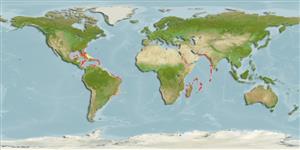>
Anguilliformes (Eels and morays) >
Chlopsidae (False morays)
Eponymy: Dr Charles Richard ‘Dick’ Robins (1928–2020) was an American systematic ichthyologist whom one etymology honoured as an ‘eelologist’; as well as a colleague, advisor and friend, for his contributions to the knowledge of fishes (including [...] Catherine Robins née Hale was honoured for her contributions to the knowledge of this ‘fascinating group of eels’ (the generic name honors her husband) (see also Robins CH & CR) (Ref. 128868), visit book page.
Environment: milieu / climate zone / depth range / distribution range
экология
морской демерсальный; пределы глубины 140 - 243 m (Ref. 40871). Tropical
Western Indian Ocean: off Kenya. Western Central Atlantic: Panama.
Size / Вес / Возраст
Maturity: Lm ? range ? - ? cm
Max length : 19.8 cm TL самец/пол неопределен; (Ref. 40871)
позвонки: 130 - 137.
Life cycle and mating behavior
половая зрелость | размножение | нерест | икра | Fecundity | личинки
Böhlke, J.E. and D.G. Smith, 1967. A new xenocongrid eel from the western Indian and western Atlantic Oceans. Not. Nat. Acad. Nat. Sci. Philad. 408:1-6. (Ref. 40871)
Статус Красного Списка МСОП (Ref. 130435: Version 2024-1)
Угроза для людей
Harmless
Использование человеком
дополнительная информация
инструменты
Специальные отчеты
Скачать в формате XML
ресурсы в Интернет
Estimates based on models
Preferred temperature (Ref.
123201): 14.6 - 22.4, mean 18 °C (based on 39 cells).
Phylogenetic diversity index (Ref.
82804): PD
50 = 1.0000 [Uniqueness, from 0.5 = low to 2.0 = high].
Bayesian length-weight: a=0.00102 (0.00046 - 0.00225), b=3.06 (2.88 - 3.24), in cm total length, based on all LWR estimates for this body shape (Ref.
93245).
Trophic level (Ref.
69278): 3.8 ±0.6 se; based on size and trophs of closest relatives
Fishing Vulnerability (Ref.
59153): Low vulnerability (10 of 100).
